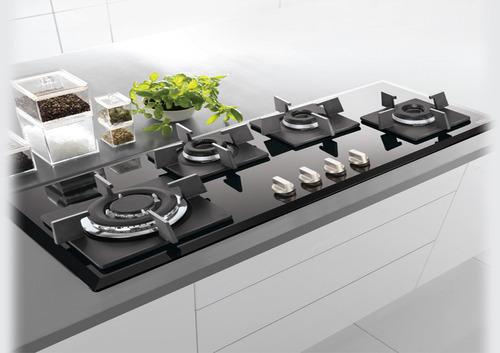
Guide to Choosing The Best Hob for Your Kitchen
With so many different hobs available online, it can be difficult to know where to start. This guide offers a simple explanation of the main types of hob, and the advantages and disadvantages of each. That way, you’ll be able to focus your search on exactly what you need.
TYPES OF HOBS
There are three popular types of hobs — gas, induction and ceramic.
Gas Hobs
A gas hob uses burners with visible flames, characterised by metal pan supports on top. They’re a traditional choice which is still popular today, and tend to be the first choice for chefs in professional kitchens.
Most of us are familiar with this type of hob in the kitchen. When the gas hob is turned on, a flame lights the gas flowing out of the burners on the cooktop, producing the fire to cook with. You can either use it with gas supplied in liquefied petroleum gas (LPG) cylinders that would have to be replaced when the gas is used up, or piped gas for convenience. As such, determine what type of gas you are using in your home, to select a compatible hob.
ADVANTAGES
- Instant, powerful heat
- Complete flexibility – no set temperature intervals
- Easy to use
- Can be used with any type of cookware
DISADVANTAGES
- Requires a gas supply, so not suitable for all homes
- Can be difficult to clean due to their burners and pan supports
- Less efficient than induction models
Induction Hobs
Induction hobs are unique in the way they heat your pans. They create a magnetic field between the induction element and the base of your cookware, heating your pan directly, rather than wasting energy heating the cooking surface. Aside from a little residual heat, the surface stays relatively cool.
Induction hobs use electromagnetism (generating electricity using magnetism) to create heat inside the cooking pan, rather than from the outside. In a way, it turns cooking pans into cookers, cooking food more directly and quickly, with less energy.
Induction hobs feature touch-sensitive buttons, and different heat settings and programmes for precision cooking, apart from safety features. They come in a variety of sizes and designs, from a portable single-burner to built-in models with multiple burners. There are some models in the market that are exceptionally versatile, such as the Brandt Maxizone and Electrolux Infinite Pure Zoneless (pictured above) induction hobs. With their flexible cooking zones, you can use cookware of almost all shapes and sizes, instead of being confined to specific heat zones.
ADVANTAGES
- Really quick to heat up
- Efficient since no energy is wasted heating the cooking surface
- Stylish designs available
DISADVANTAGES
- Restricted to which pans you can use – cast iron or steel cookware is ideal, but aluminium or copper pans won’t work unless the base has an additional layer which a magnet will stick to
Ceramic Hobs
The phrase ‘ceramic hob’ simply refers to its sleek ceramic glass finish. That means technically, gas on glass and induction hobs are also ceramic hobs. However, most of the time, if a product is advertised as a ‘ceramic hob’, it will be electric, and there are a number of different ways it could work.
Ceramic hobs look similar to induction hobs, but the key difference between them is that ceramic hobs makes use of an element underneath the cooker’s surface, which heats up and transfers the heat to the cooking pan. As such, the surface of the hob will be hot.
ADVANTAGES
- Sleek finish for a premium feel
- Frameless designs are available for an impression of fluidity between your worktops and hob
DISADVANTAGES
- Often more expensive than electric plate or gas hobs
- With standard radiant elements heat isn’t very evenly distributed across the base of a pan and can be difficult to control
For Best Deals related to Hob please contact us.
Featured Image Source: indiamart.com